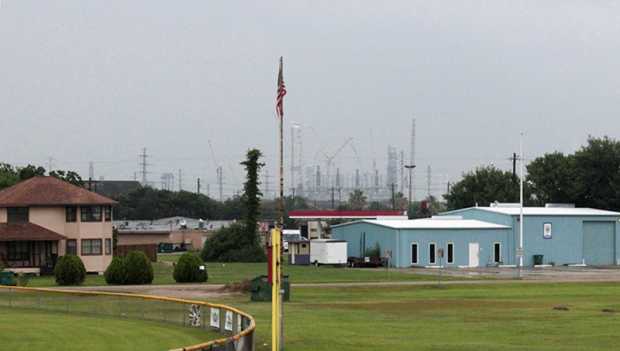Global Warming And The Texas Surge Of New Chemical Plants

Dave Fehling
Along the Texas Gulf Coast, billions is being spent to build or expand petrochemical plants.
A big, new expansion of a petrochemical plant is under construction in Clear Lake. It’ll make methanol, a key ingredient for producing other chemicals. But will it also make pollution that will add to global warming?
The expansion of an existing complex owned by Celanese is part of trend along the Texas Gulf Coast as low prices for natural gas have made making chemicals cheaper.
“There’ve been several methanol and ammonia plants proposed for the area. And those are very natural gas intensive,” said Katie Teller, an analyst with the Federal Department of Energy.
The Celanese expansion in the suburbs south of Houston will provide jobs and tax revenues. But according to the Sierra Club, that plant and other new petrochemical facilities along the coast will substantially increase greenhouse gas emissions — like carbon dioxide — that are linked to global warming. Curbing those gases is at the heart of new rules from the federal Environmental Protection Agency.
The State of Texas has fought the rules, claiming they’ll hurt economic growth. Last month at a symposium challenging climate change, Brook Rollins, president of the conservative Texas Public Policy Foundation, said policies like the ones to curb greenhouse gases were based on flawed science.
“The peril of a dangerously warming planet is the successor — if we all remember — to the peril of a new ice age, which is exactly what many scientists predicted in the 1970’s,” Rollins said in comments leading up to a speech by Governor Rick Perry.But lawsuits by Texas and other states to block the new rules failed earlier this summer when the U.S. Supreme Court upheld them. So now, the new rules are taking effect. What’s been the impact? The Celanese plant may be an early example.
Before construction could begin, the EPA had to decide what Celanese would be required to do to reduce greenhouse gas emissions. By one estimate cited in EPA documents, all the extra equipment to capture the carbon dioxide generated by the chemical processes at the plant would have increased the cost to build it by 25 percent and added a staggering $34 million dollars to the annual cost to run it.
“The whole issue of carbon capture and storage is a pipe dream, someday it may be technically feasible, some day it may be economically feasible. It is not today,” said Stephen Minick with the Texas Association of Business.
When presented with these arguments, the U.S. Environmental Protection Agency’s regional office in Dalla agreed. It called the carbon capture measures “economically infeasible.”
It was a defeat for the Sierra Club which had challenged the cost estimates as “grossly overstated” and suggested the plant was exactly the sort of project for which carbon capture should be required.
The plant will still have to take other measures to reduce greenhouse gas emissions like using cleaner burning furnaces and the latest leak detection devices. But overall, was it a win for the petrochemical industry?
Minick, with the business association, said not really because “our whole issue is over precedent.”
He said the precedent of allowing increased regulation of greenhouse gases could still threaten economic growth down the road despite what happened with the expansion of the Celanese plant which is expected to start operating next year.
So far in Texas, the EPA says it has issued 54 greenhouse gas permits. Seven more draft permits are now up for public comment and 12 more applications are in development.
